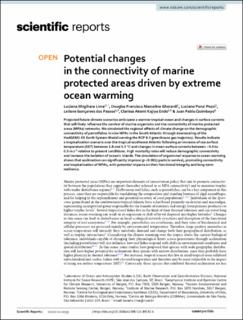| dc.contributor.author | Lima, Luciana S. | |
| dc.contributor.author | Gherardi, Douglas Francisco Marcolino | |
| dc.contributor.author | Pezzi, Luciano P. | |
| dc.contributor.author | Goncalves Dos Passos, Leilane | |
| dc.contributor.author | Kajiya Endo, Clarissa Akemi | |
| dc.contributor.author | Quimbayo, Juan Pablo | |
| dc.date.accessioned | 2021-07-09T12:11:09Z | |
| dc.date.available | 2021-07-09T12:11:09Z | |
| dc.date.created | 2021-05-14T13:26:38Z | |
| dc.date.issued | 2021 | |
| dc.identifier.issn | 2045-2322 | |
| dc.identifier.uri | https://hdl.handle.net/11250/2764065 | |
| dc.description.abstract | Projected future climate scenarios anticipate a warmer tropical ocean and changes in surface currents that will likely influence the survival of marine organisms and the connectivity of marine protected areas (MPAs) networks. We simulated the regional effects of climate change on the demographic connectivity of parrotfishes in nine MPAs in the South Atlantic through downscaling of the HadGEM2-ES Earth System Model running the RCP 8.5 greenhouse gas trajectory. Results indicate a tropicalization scenario over the tropical southwest Atlantic following an increase of sea surface temperature (SST) between 1.8 and 4.5 °C and changes in mean surface currents between − 0.6 to 0.5 m s−1 relative to present conditions. High mortality rates will reduce demographic connectivity and increase the isolation of oceanic islands. The simulation of organismal response to ocean warming shows that acclimation can significantly improve (p < 0.001) particle survival, promoting connectivity and tropicalization of MPAs, with potential impacts on their functional integrity and long-term resilience. | en_US |
| dc.language.iso | eng | en_US |
| dc.publisher | Nature Research | en_US |
| dc.rights | Navngivelse 4.0 Internasjonal | * |
| dc.rights.uri | http://creativecommons.org/licenses/by/4.0/deed.no | * |
| dc.title | Potential changes in the connectivity of marine protected areas driven by extreme ocean warming | en_US |
| dc.type | Journal article | en_US |
| dc.type | Peer reviewed | en_US |
| dc.description.version | publishedVersion | en_US |
| dc.rights.holder | Copyright The Author(s) 2021 | en_US |
| dc.source.articlenumber | 10339 | en_US |
| cristin.ispublished | true | |
| cristin.fulltext | original | |
| cristin.qualitycode | 1 | |
| dc.identifier.doi | https://doi.org/10.1038/s41598-021-89192-6 | |
| dc.identifier.cristin | 1910030 | |
| dc.source.journal | Scientific Reports | en_US |
| dc.identifier.citation | Scientific Reports. 2021, 11, 10339. | en_US |
| dc.source.volume | 11 | en_US |

